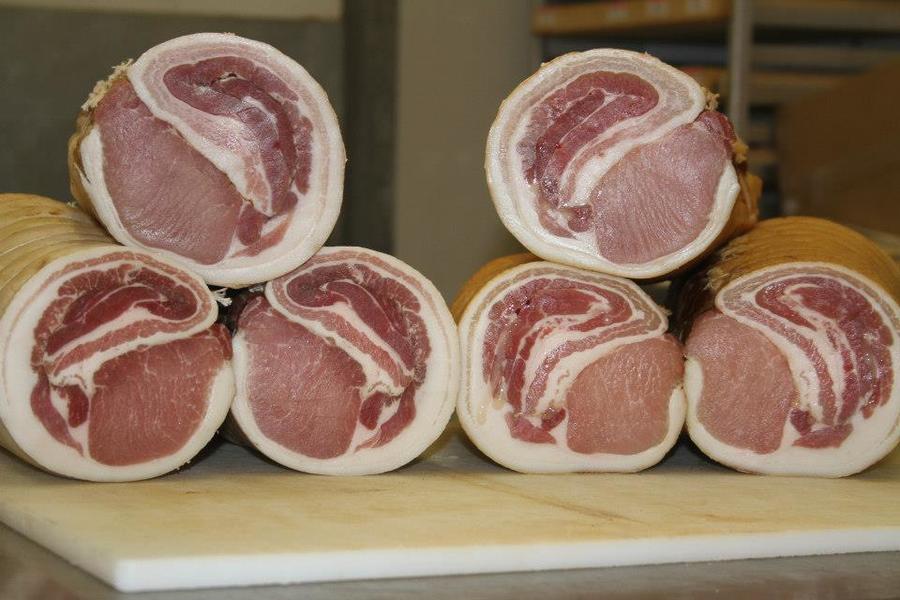If you're talking fressh un-prepared casings straight from a hog there's MUCH more to prepping them!!!!
Here's the deal, summed up by vagreys:
"The casing is just the outer membrane of the intestine. You want to
clean the intestine as thoroughly as possible, and to remove the inner
membrane and lining of the intestine to minimize the risk of parasites
and contamination. Flushing the intestines is only the first step. To
prepare hog casing:
1. Remove the intestine section from the fatty caul membrane. You
should be able to pull the intestine out of the fatty membrane,
easily.
2. Rinse the intestine thoroughly. As you say, rinse until the water
runs clear and you are satisfied that you have removed all solids and
intestinal worms, and that it is thoroughly rinsed. This is only the
first step in preparing the casing, though.
3. Take the cleaned intestine and put it in a clean container while
you prepare this step. You will soak the intestine in a container of
heavily salted cool water for several hours. You want the water very
salty, and the salt dissolved.
4. After several hours of soaking, the salt will have penetrated the
entire intestine and further cleaned the intestine. The next step is
to turn the intestine inside out, and remove the pale pink inner
mucosum, leaving only the white outer membrane - the casing.
5. This step is optional. When we made casing on the farm, before
turning the intestine inside out, we laid out the intestine and used a
rolling pin and, starting at one end, pushed as much of the pale pink
mucosum interior of the intestine as we could out the other end. You
don't have to do this step, but I think it helps. Make sure the casing
is flat when you do this.
6. Turning the intestine inside out is relatively easy if you can use
cool, clean running water. Start by taking one end of the intestine
section and turn it inside out with your fingers. You only need to get
it started by turning an inch or few. Then, run water into the pocket
created by turning the intestine, and let the weight of the water do
the work for you, keep running water into the pocket you created and
it will pull the rest of the intestine through, turning it inside out
as it does - all you need to do is keep a firm grip on the end that
was turned, and juggle the intestine gently under the running water to
get it to pull the rest of the intestine through the fold you created.
I started out not doing this, but read about the technique, tried it,
and never looked back.
7. With the intestine turned inside out, it is time to remove the
inner mucosum - the pale pink interior of the intestine - leaving
behind the white outer membrane that is the casing you will use. Use a
straight-edged, dull blade, such as a spreader or butter knife, to
scrape away the pale pink membrane. This will take some work and
patience, but you will quickly see the thin, white outer membrane as
you scrape away the pink mucosum. Be careful not to cut or tear the
outer membrane. When you are done, all that will remain is the white
outer casing.
8. Rinse the scraped casing thoroughly to get rid of any remaining
bits of mucosum. Then turn the casing right side out. Put about a
tablespoon's worth of salt into each end of the casing, add about a
teaspoon of water to each end and work the salt slurry through the
interior of the casing, trying to distribute the salt as evenly as you
can. Once that is done, dry the casing a little so that it is still
slightly wet but not dripping wet. Place it into a container with a
tight-sealing lid. Add about 150 grams (about a half cup) of
non-iodized fine salt to the container and gently toss the casing in
the salt until all of the casing is coated in salt. Cover tightly and
refrigerate.
When you are ready to use your casing, you will need to prepare it as
you would any commercial casing, by rinsing and soaking and checking
for leaks.
This is how we used to do it. Most books on butchering recommend
something similar. Hope this helps.
I remember pretty much the same process, only one part that sticks out
for me was scraping was replaced by pulling the inverted casings thru
a zig zag of 3 knives sandwiched in a vice, the center one inverted.
My father would have me weave the casings thru such that the back side
of the knives contacted the casing, doing the scraping. Have not tried
that since I was a kid, but pretty sure it would still work. But
definitely invert them and scrape!"
~Martin





